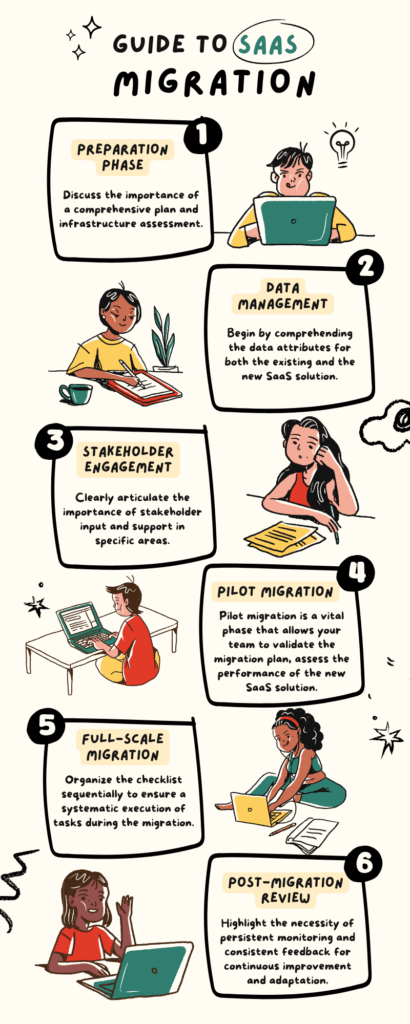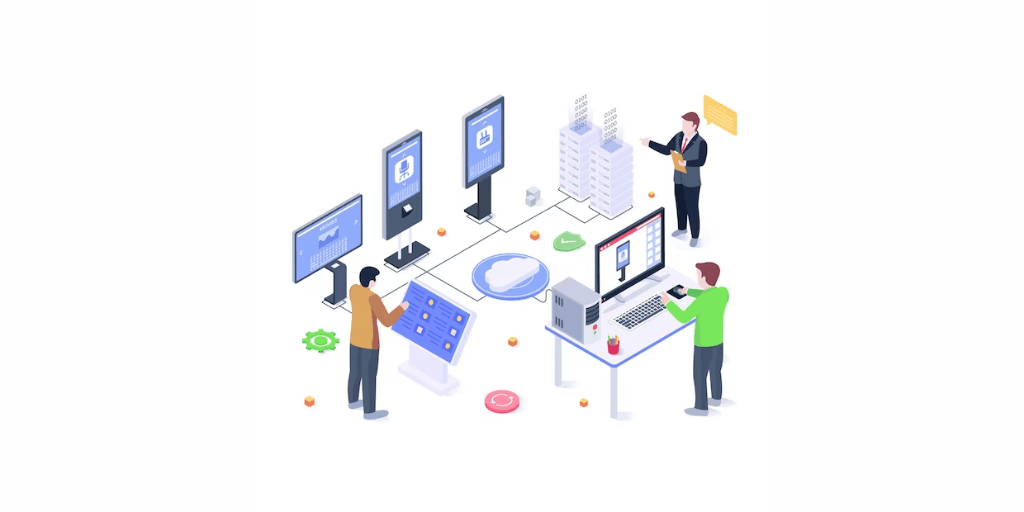
In the fast-evolving landscape of modern business, the decision to migrate to Software as a Service (SaaS) is a strategic move that can significantly enhance operational efficiency.
Planning for this migration is paramount, as it sets the stage for a seamless transition. Without a meticulous plan, organizations risk facing various challenges, such as data loss, system downtime, and disruptions to daily operations.
A well-thought-out migration plan not only minimizes these risks but also ensures that the migration aligns with business objectives and delivers a positive impact on productivity and functionality.
The consequences of inadequate planning can include financial setbacks, loss of customer trust, and an overall negative impact on the organization’s ability to leverage the benefits of SaaS technology effectively.
This guide emphasizes the importance of a comprehensive plan to mitigate risks and unlock the full potential of SaaS migration.
 Steps To Follow
Steps To Follow
1. Create a Migration Plan

Initiate the SaaS migration journey by assembling a cross-functional team and conducting a thorough analysis of your current state. Identify areas that require changes, such as software applications, data structures, and integration points. Utilize straightforward project management tools like Asana or Trello to document tasks, set timelines, and facilitate collaboration. As a value addition, create a detailed roadmap for migration, outlining key milestones and dependencies. Additionally, design use cases and a comprehensive testing plan to ensure that each aspect of the migration is thoroughly validated before implementation.
 Pro Tip
Pro Tip
Ensure key stakeholders are involved from the start to gather diverse insights and perspectives, enriching the migration plan with a holistic understanding of the organization’s needs and objectives.
2. Assess Current Infrastructure

The assessment of your existing IT infrastructure is a crucial step in the SaaS migration process as it provides a comprehensive understanding of your organization’s technological landscape. This analysis is essential to identify the compatibility of current applications and data structures with the chosen SaaS solution. It helps uncover potential bottlenecks, dependencies, and areas that may require modification for a smooth transition. If changes are deemed necessary, formulate a strategy to address these modifications, ensuring that existing systems align seamlessly with the new SaaS platform. User-friendly tools such as Microsoft’s Azure Migrate or AWS Migration Hub can assist in this evaluation, providing detailed insights that guide decisions on necessary adjustments. As a value addition, employ network mapping tools to visualize dependencies, facilitating a streamlined approach to addressing modifications and minimizing disruptions during the migration.
 Pro Tip
Pro Tip
Regularly communicate with the IT team and stakeholders to ensure a comprehensive understanding of the organization’s infrastructure and a collaborative approach to addressing any required changes.
3.Identify Legacy Data Migration

Prioritize a thorough understanding of your legacy data, recognizing that the successful migration of data is integral to a seamless transition. Begin by comprehending the data attributes for both the existing and the new SaaS solution. This understanding ensures that data is appropriately mapped, preventing inconsistencies and data loss during the migration process. As a valuable addition, seek out a data migration playbook from the new SaaS vendor, leveraging their expertise and best practices accumulated from numerous migrations. This resource can offer insights into common challenges and effective strategies for a smoother transition. Additionally, use this opportunity to enhance data accuracy and consistency, implementing data cleansing and validation processes.
 Pro Tip
Pro Tip
Engage data experts within your organization to collaborate with the SaaS vendor, ensuring a meticulous mapping of data and capitalizing on this migration phase to elevate the overall quality of your data.
4.Engage Stakeholders and Training

Effective communication with stakeholders is paramount during the SaaS migration process. Clearly articulate the significance of their involvement, emphasizing specific areas where their input and support are crucial. Set expectations regarding timelines, functionalities, and the overall impact on daily operations to foster a shared understanding. As part of this engagement, establish a comprehensive training plan for end-users, utilizing straightforward communication channels such as Slack or Microsoft Teams.
 Pro Tip
Pro Tip
Develop an inclusive approach by creating FAQs and user guides to address common queries, helping stakeholders comprehend the migration’s objectives and potential disruptions. Regularly update stakeholders on progress, ensuring a collaborative and informed environment throughout the migration process.
5.Perform a Pilot Migration

The pilot migration is a vital phase that allows your team to validate the migration plan, assess the performance of the new SaaS solution, and troubleshoot any unforeseen issues before implementing the full-scale migration. This critical step involves testing the migration thoroughly using actual use cases, simulating real-world scenarios to identify any potential issues or challenges. Leverage tools like CloudEndure or Azure Site Recovery for a controlled pilot migration, ensuring you run this on a beta environment.
 Pro Tip
Pro Tip
Monitor key performance metrics closely during the pilot to identify potential bottlenecks, allowing for proactive optimization before the complete transition. This practice ensures a smoother experience for end-users and minimizes disruptions to business operations when executing the full-scale migration.
6.Execute the Full-scale Migration

As you gear up for the final step, it’s crucial to prepare a comprehensive go-live plan and checklist. Organize the checklist sequentially to ensure a systematic execution of tasks during the migration. Choose a go-live time strategically, aiming to minimize downtime and its impact on users. Once the migration is complete, rigorously test all use cases to validate the functionality of the new SaaS solution. Employ automated tools such as Datadog or New Relic to create alerts and detect any errors promptly. These tools enhance your ability to monitor real-time insights into system performance and swiftly address any issues that may arise during the initial stages of the full-scale migration.
 Pro Tip
Pro Tip
Regularly communicate with the IT team and stakeholders, keeping them informed about the progress and addressing any concerns promptly to maintain a seamless transition for end-users.
Conclusion
Embarking on the SaaS migration journey demands a strategic approach, blending meticulous planning with the right set of tools and continuous engagement.Without a meticulous plan, organizations risk facing various challenges, such as data loss, system downtime, and disruptions to daily operations. A well-thought-out migration plan not only minimizes these risks but also ensures that the migration aligns with business objectives and delivers a positive impact on productivity and functionality. So, whether you’re a seasoned professional or new to the world of SaaS migration, follow these steps diligently to make your journey a smooth and successful one.

